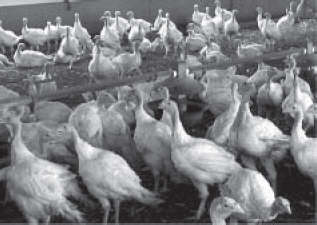



Corona Virus Infections in Turkeys
By F. Dustan Clark, Extension Poultry Health Veterinarian at the University of Arkansas's Avian Advice - Corona viruses are small viruses that are named corona because it has projections on its surface that resemble a crown. The viruses are widespread in nature and are responsible for respiratory and enteric diseases in cattle, dogs, pigs, rabbits, humans, turkeys, chickens as well as other animals. This report looks into the diagnosis and treatment of this virus.| More on the Author | |
| Dr. Dustan Clark Extension Poultry Health Veterinarian |
|
Introduction
In cattle and pigs corona virus causes intestinal infections that result in weight loss, diarrhea, and in some instances death. In broilers, a corona virus is the causative agent of infectious bronchitis. In contrast to chickens, turkeys infected with corona virus develop an enteric disease similar to mammalian species.
History:
The disease in turkeys was first seen in the state of Washington in the late 1940s and in the early 1950s in Minnesota where it caused heavy losses. The disease was referred to as “Mud fever” and “Bluecomb” but the causative agent was not identified as a corona virus until many years later. The disease has been seen in most if not all of the turkey producing areas of the United States, but is not a common isolate from normal turkeys. However, turkey flocks in Arkansas and Missouri continue to have problems with the disease.
Clinical Signs:
 The virus can infect almost any age turkey but, the disease is more of a problem in poults
during the first few weeks of life. The incubation period of the disease is within five days of
exposure with most cases developing in two to three days. One of the most common signs is a
sudden onset of depression, a drop in consumption of water, decreased appetite, and watery
diarrhea in a large numbers of birds. The affected birds also chirp frequently, lose weight, and
huddle together. Usually the entire flock is exposed to the disease, but mortality associated with the disease is commonly between 5-50%, but a few outbreaks it has exceed 50%. The number of
affected birds may reach 100%. Flocks that have the disease have growth depression, stunting,
weight loss, poor feed conversion, and are extremely uneven in size.
The virus can infect almost any age turkey but, the disease is more of a problem in poults
during the first few weeks of life. The incubation period of the disease is within five days of
exposure with most cases developing in two to three days. One of the most common signs is a
sudden onset of depression, a drop in consumption of water, decreased appetite, and watery
diarrhea in a large numbers of birds. The affected birds also chirp frequently, lose weight, and
huddle together. Usually the entire flock is exposed to the disease, but mortality associated with the disease is commonly between 5-50%, but a few outbreaks it has exceed 50%. The number of
affected birds may reach 100%. Flocks that have the disease have growth depression, stunting,
weight loss, poor feed conversion, and are extremely uneven in size.
Lesions:
The lesions found with the disease consist of droopy wings, fecal staining of feathers, mucus or urates in the feces, pale flaccid small intestines, watery cecal contents, weight loss, dehydration, and atrophy of the Bursa of Fabricius. Since the Bursa of Fabricius produces immunity, the loss of this organ makes birds more susceptible to other disease organisms. When the disease affects breeder turkeys the eggshell quality usually deteriorates with eggs lacking pigment and having chalky shells. The only clinical sign that may appear in breeder turkeys may be a sudden drop in egg production.
Virus transmission:
The corona virus is shed in the feces of affected turkeys and is ingested by other turkeys. Insects are also mechanical vectors for the transmission of the disease. The disease spreads rapidly within in a flock and can be carried to other flocks via mechanical vectors such as people, vehicles, equipment, and animals. The virus is usually shed for several weeks after birds have recovered and can infect susceptible birds. Since older birds have been identified as a reservoir of infections for younger birds, it is crucial to avoid having different age birds on the farm.
Prevention and Treatment:
Recovered birds are resistant to infection; however, the extent and nature of the immunity is
not fully understood. Since there is no cure for the disease, supportive care is recommended.
Supportive care might include providing extra heat, use of milk replacers or calcium chloride in the water to aid in control of dehydration and control of secondary bacterial disease with appropriate antibiotics. However, supportive care has been used with mixed success in field outbreaks.
Corona viruses are readily inactivated by most common disinfectants, but can persist for
extended periods in dirty or contaminated locations. Farms that have experienced the disease
should be cleaned and disinfected after all fowl have been removed from the premises. Equipment,
vehicles, and anything that will contact birds should be also be cleaned and disinfected. Recent
research has shown that flies may be an important vector for carrying the viruses from house to
house or farm to farm so insect control should be implemented. Additionally, a period of three to
four weeks should elapse before new birds are introduced into the facilities.
The best method to control the disease is to prevent it from entering a flock. A good biosecurity
program should be used to assist in the prevention of accidental introduction of the disease via
vehicles, people, and/or equipment.

Source: Avian Advice - Winter 2003 - Volume 5, Number 4








